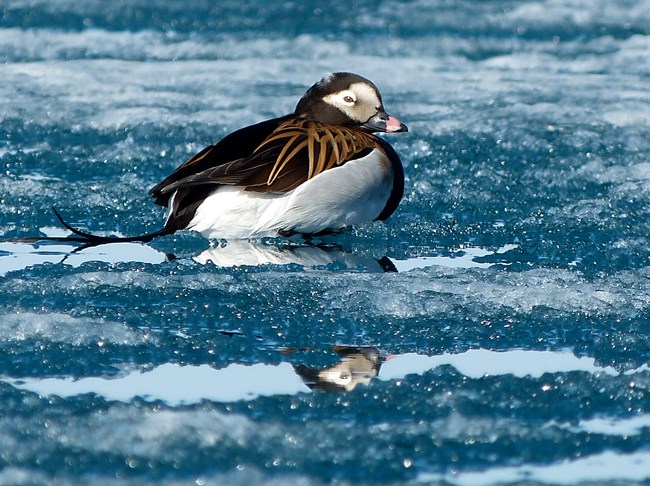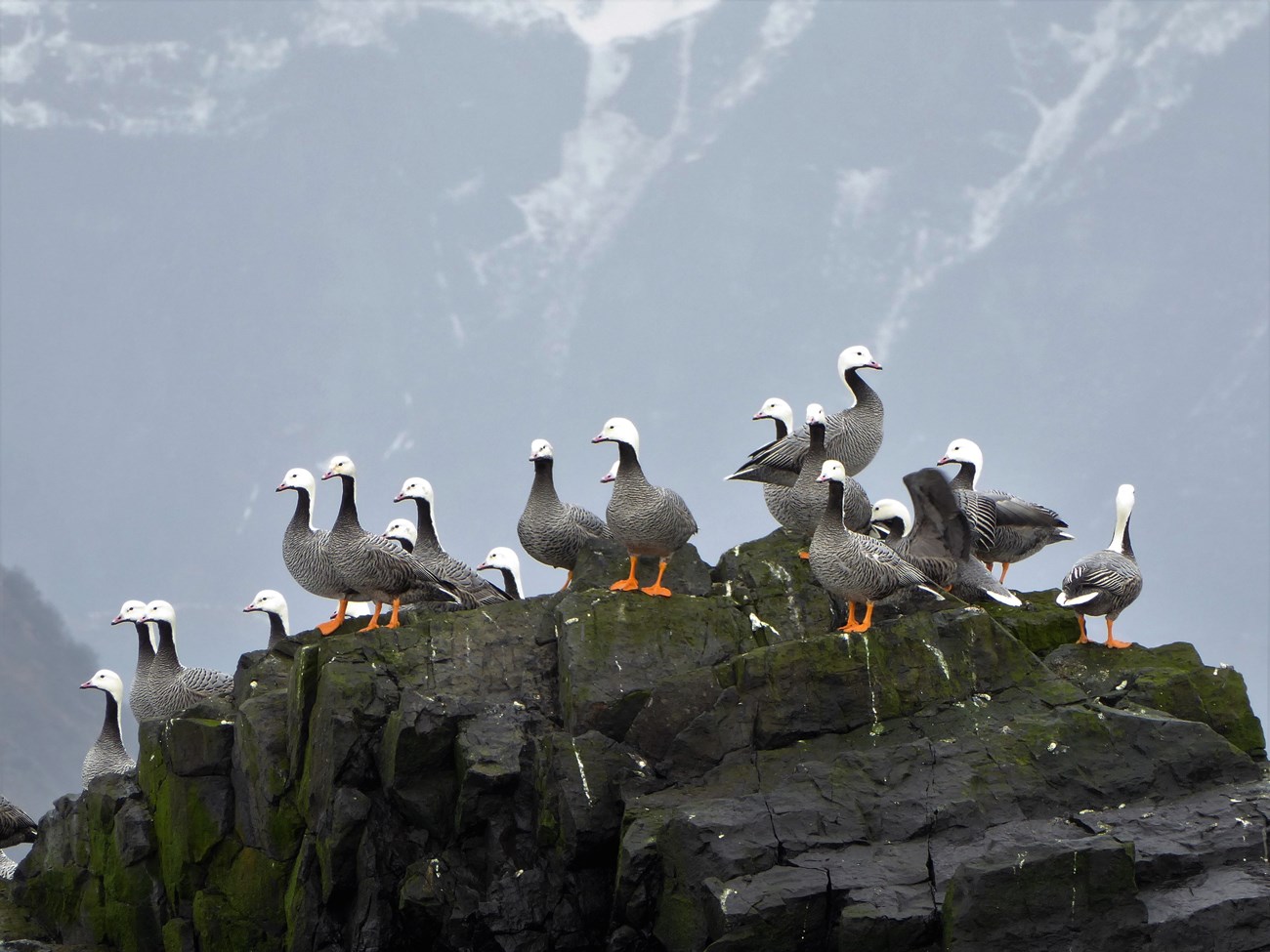Last updated: October 26, 2021
Article
Winter Marine Bird Survey - Part I
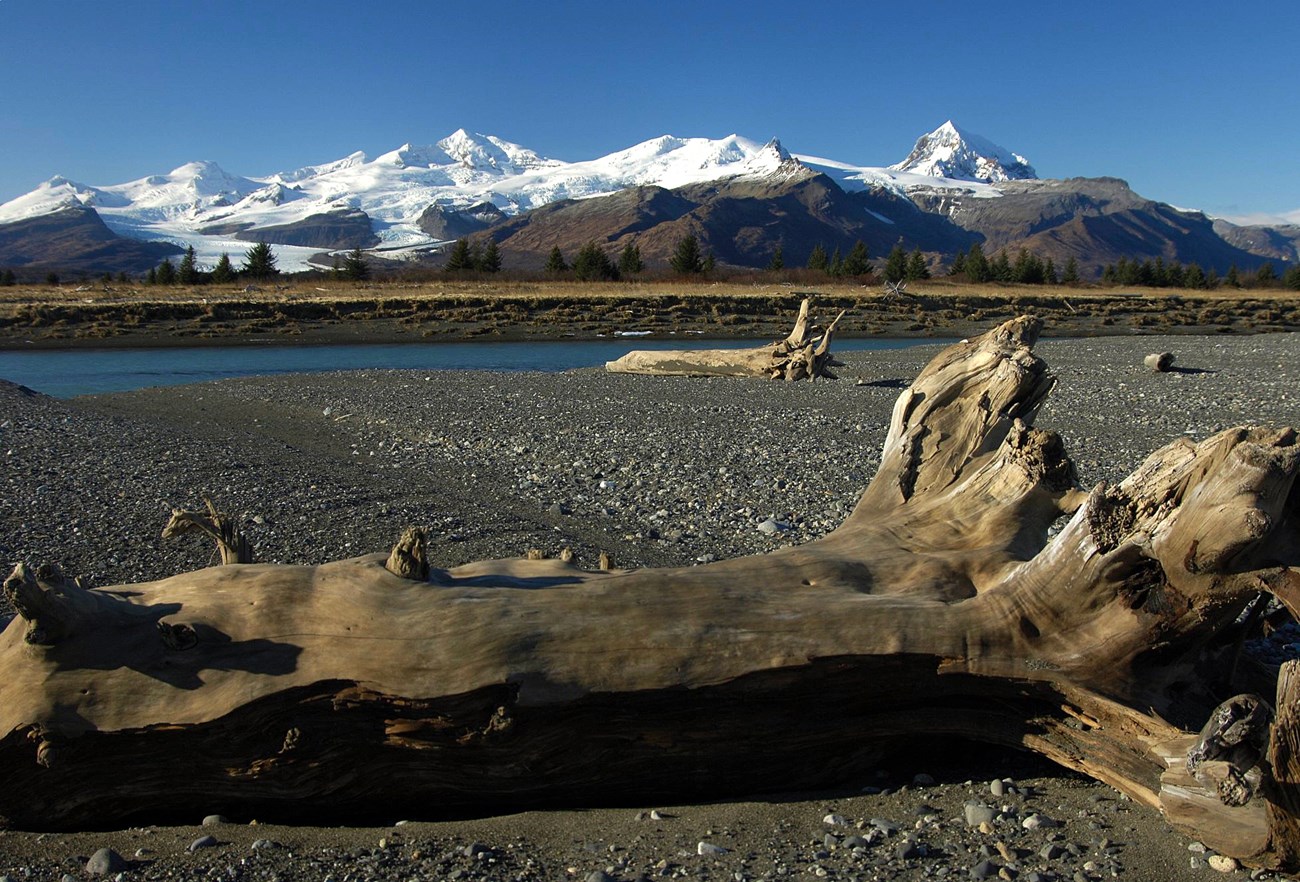
When the Birding Gets Tough, the Tough Get...More Hand Warmers
Part One
Written by Deanna Ochs
(As a science communicator for the National Park Service, Deanna joined a team of researchers on a winter bird survey along the Katmai coast. A relative new-comer to Alaska and to field work, this was her first survey.)

Think Alaska. Think coastal Alaska. Think coastal Alaska in the winter. Now, imagine skipping along that coast in an open air motor boat at around 15 knots per hour for ohhhh, say, 10 hours…in a row. Welcome to the 2018 Katmai National Park Winter Marine Bird Survey!
To be fair, it was a mild winter…for Alaska. We had Mustang suits (essentially buoyant, body armor designed for cold weather boating) and bellies full of Belgian waffles with blueberries and homemade whipped cream. Not insignificantly, the team was also possessed of a driving commitment to sound science, and a passion for coastal birds and the wild places that sustain them.
"Nature will be all ours." Dan Esler, USGS Wildlife Biologist
For more than a decade, the National Park Service, the US Geological Survey and Gulf Watch Alaska have been teaming up to monitor marine birds found along the shorelines of Katmai and Kenai Fjords national parks. These surveys are conducted annually in summer and semi-annually in winter. Why winter, you ask? Scrambling to pack the proper gear for this excursion, I had to wonder the same thing. Turns out, the answer is pretty simple. The birds that winter along the coastline differ from the birds of summer. If researchers only went out in the gentler season, parks would have a skewed picture of the birds that use their coastlines. Besides, who ever said summers here were gentle?
Alaska’s vibrant coastal regions serve as well-stocked pantries, protective nurseries and prime real estate for thousands of marine species. Many birds rely heavily on this area to sustain them throughout the long winter. If they emerge in springtime nurtured and well-fed, they are more likely to breed successfully. Because they consume the mussels, clams and other invertebrates here, these birds are good indicators of change in marine ecosystems.
The nearshore is highly susceptible to disturbances, such as oil spills and a changing climate. In 2016, the survey crew recorded huge numbers of dead seabirds along Katmai’s coast. Results would later reveal that they had starved during a period of unusually high ocean temperatures that negatively impacted their food sources. As a follow-up to that survey, this year’s results would be of particular interest.
In addition to tallying animals, these studies help identify critical coastal areas in the parks. They highlight where birds congregate and which species are likely to be found there. Armed with such specifics, park management is better equipped to develop policies protecting sensitive areas when faced with human impacts to the coast, such as oil spills, development, and changing shipping lanes.
In other words – we had good reasons for venturing out into the cold.
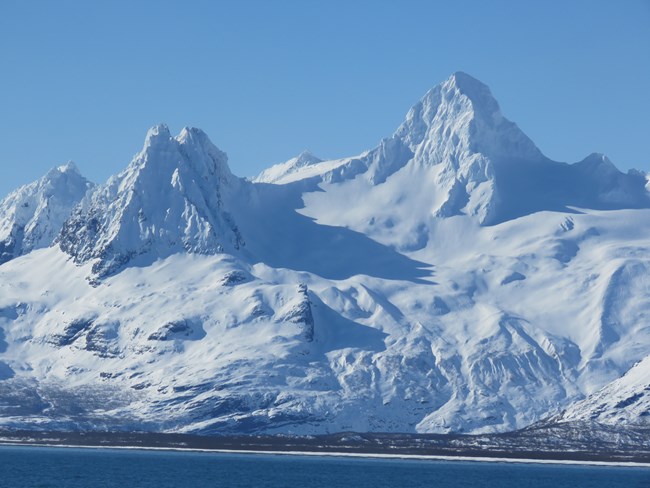
Day One: Go Time!
The Dream Catcher, our home base for the trip, nosed out of Homer’s marina late in the evening of March 14, and headed across Cook Inlet toward Katmai’s Cape Douglas. We would begin our surveys at first light.In the morning, however, the sea was roiling and churning, giving the craft fits as she lurched up one side of a wave and shuddered down the other. I feel pretty sure we caught air a few times. In the wheelhouse, a grim-faced captain gingerly negotiated his way through the chop, taking some waves head on, while doing his best to skirt the gnarliest of them. Below decks, except for the occasional crash of some large object hitting the floor, an unnerving quiet pervaded. Straight ahead, the stolid peaks of Cape Douglas, encased in snow, stood in stark contrast to the frothy steel-gray waters. I recalled the trip leader’s words of the previous day. “We won’t likely see any other boats out there until we get back to Cook Inlet. Nature will be all ours.”
It had sounded amazing. At the time.
The hours ticked by….six and counting. By 10:00 am our 7:00 o’clock breakfast had yet to appear. By 11:00 I had ceased kidding myself that food would stay put, anyway, and staggered to the back of the boat to sleep off my queasiness. Curled up on the cool floor, without the gumption to even pull a blanket over me, I engaged in a little self-soothing. This was nothing new to the captain, I reminded myself. He and his crew had a solid reputation and had made it clear that safety was paramount. We were in good hands. A gentle calm settled over me and I drifted off.
Three hours later I awoke to blessed tranquility, and the smell of food. It was go time.
After lunch, we loaded the skiffs and prepared to head out. Ok, to be fair, the others loaded the skiffs. I was in my cabin sweating, grumbling and stuffing myself, adorned with an absurd number of clothes, into my unwieldy Mustang suit. At long last, I headed to the deck, dropping gloves, juggling water bottles (which I discovered later were somewhat superfluous), leaving a trail of hand warmers like breadcrumbs behind me, and dragging some unidentified cord that was attached to the suit. I figured it had something to do with cold water rescue and frankly, I didn’t want to have to think too much more about it. I approached the skiff to find three bright orange bodies sitting primly in place, looking straight at me. I’m pretty sure, at that point, that I wasn’t the only one wondering just what I was getting into.
I tumbled into place, and we were off. It was 5:00 pm, but the sun was warm, the water a deep turquoise and the views were stunning. I felt as if I had discovered Alaska’s best kept secret.
The seven of us were split up into two skiffs. One puttered off to survey birds. Mine set off to locate cameras put in place to record the secret lives of Alaska’s coastal mammals. (Access to these areas being what it is, researchers often conduct multiple studies on a given trip.) Trained on popular haul out sites, the cameras have been snapping photos every few minutes since July in an effort to document bears preying on seals and sea otters.
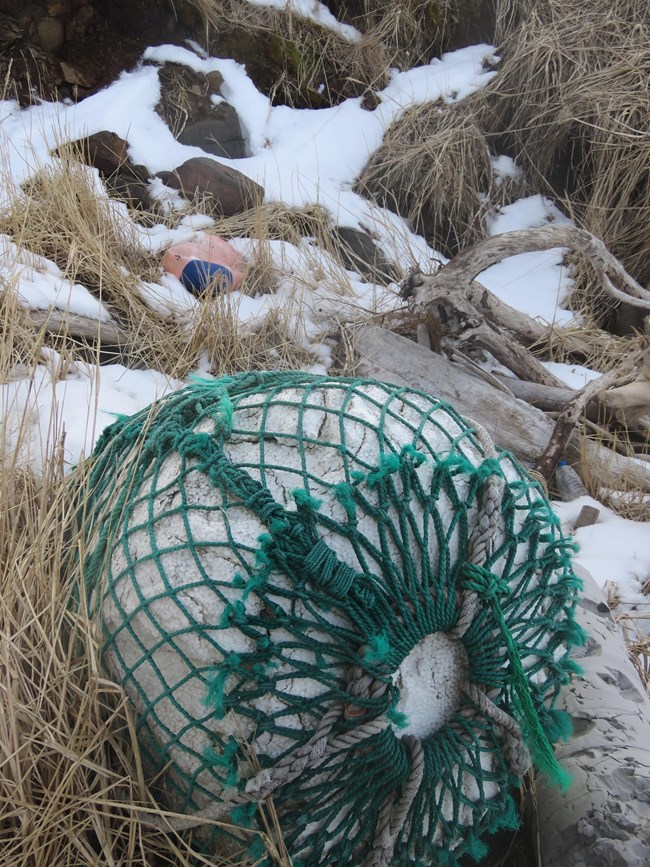
While some of our crew tended to the cameras, two of us scoured beaches for bird carcasses. We lumbered around clumsily, carefully picking our way over and around slimy rocks, as much to prevent injury as to avoid having to erect ourselves again. Every once in a while, to my deep dismay, I heard the crackling of discarded plastic bottles under foot. I knew marine debris was everywhere but this really hit home. Learn more and find out how you can help!
Dead birds found were to be bagged and brought back for examination. Large numbers of carcasses could indicate another massive die off. But the beaches appeared to be carcass-free. Considering that during the 2016 survey every section walked had been littered with dead birds, we took this as a hopeful sign. When later someone asked why we hadn’t removed our jumpsuits on the island, I sat dumbfounded. The thought had simply not occurred to me.
Accessing the cameras inside their metal cases proved to be too difficult in the field. Like me, their working parts weren’t functioning so well after intense bombardment by the elements. We hauled them back to the skiff for some needed TLC and, in the gathering dusk, headed for the beckoning lights of the Dream Catcher.
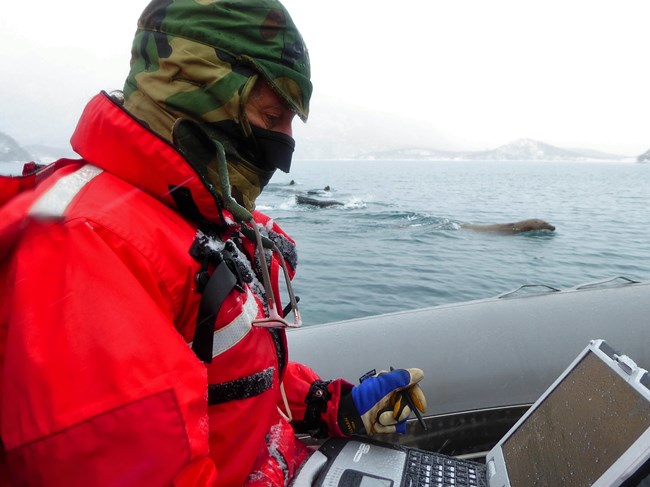
Day 2: No Escape
On this day both boats were to conduct surveys. At 8:00 am we headed out into gray skies that reached the horizon, and a sloppy, cold drizzle. The skiff’s hull chopped through newly formed sheets of ice on the water’s surface. Later, Mary, a crew member on the other skiff, reported, “Our boat was so icy this morning, we all just slid in like sea otters!” No Club Med today.We were four people on board. One would steer the skiff and scout for birds, a second would count birds as well and a third recorded the data in the “Toughbook” computer. Accessorized like a Camaro jacked up on mag wheels, this thing was ready for whatever nature hurled at it. I observed the person typing in data, in preparation to take over the duty. We would survey five stretches of coastline (transects) in Kukak Bay today, following our progress on the computer screen.
We arrived on our first transect and the birders began calling out sightings. “Four white-winged scoters on the water!” “One long-tailed duck in the air!” “Six EMGOs (biologist speak for emperor geese) on land!” At times the sightings came fast and furious and I was amazed at how smoothly the data keeper handled it all. It seemed quite a feat – deciphering the confusing bird codes, nimbly plucking at tiny keys with bare (read: numb) fingers, scrutinizing the rain spattered screen, wiping it off with wet sleeves, only to smudge the droplets into one long smear. Her accuracy, however, was remarkable. This whipper snapper had done this before. I was fully aware that precision was critical. As Heather Coletti, marine ecologist for the National Park Service and one of the survey designers had impressed upon me, “We are collecting truth.” And, while it was reassuring to know that our data would later be combed over, I squirmed thinking about my turn at the “wheel.”
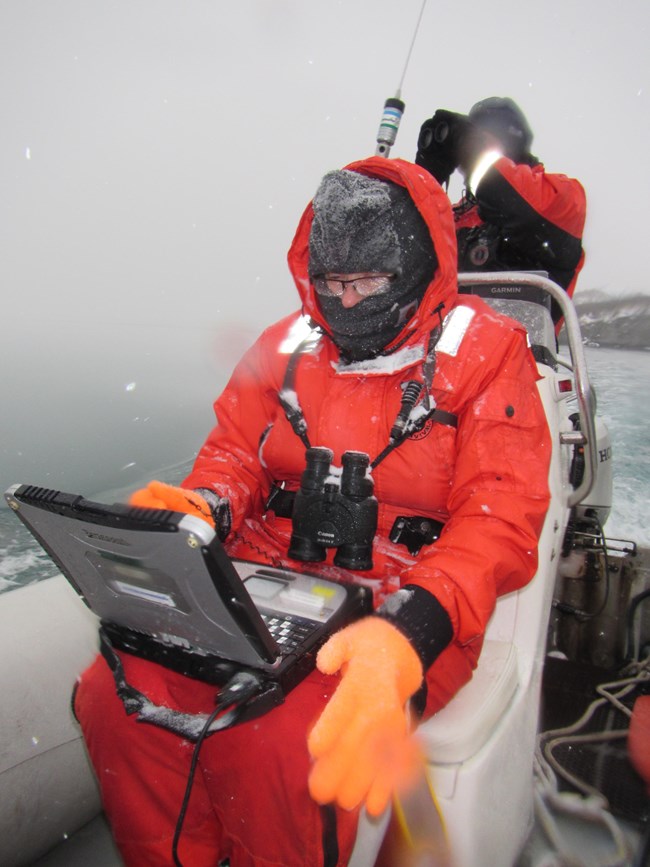
"We are collecting truth." Heather Coletti, NPS Wildlife Biologist
